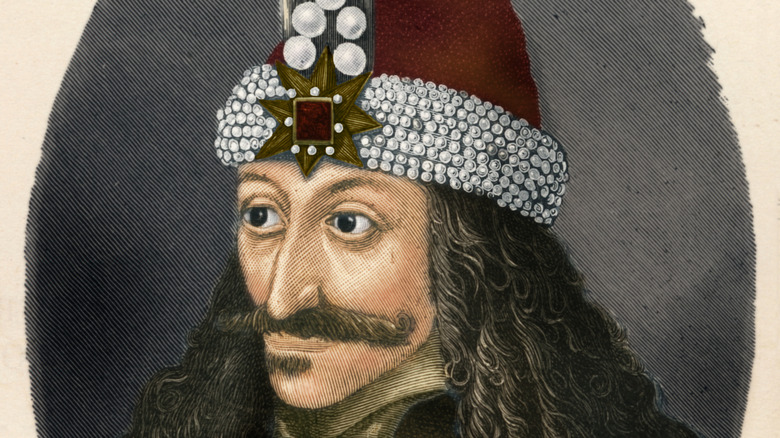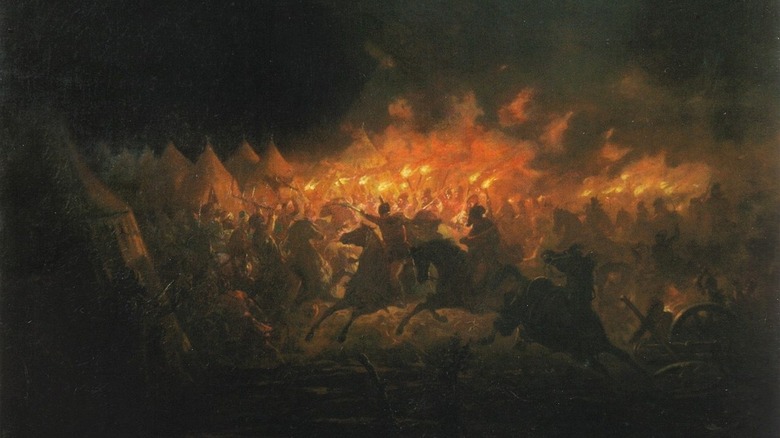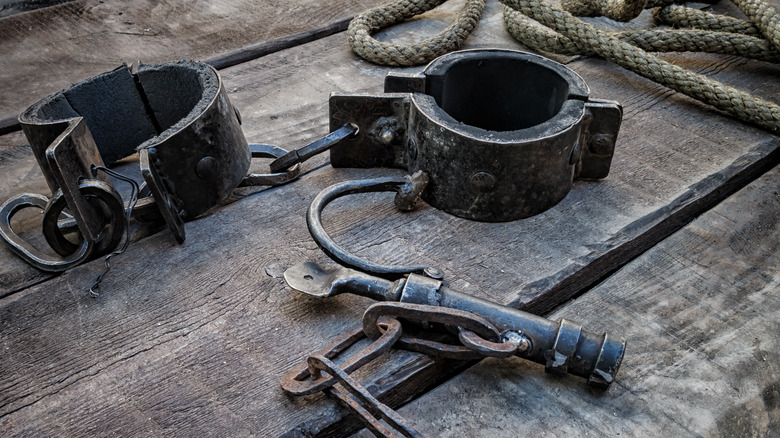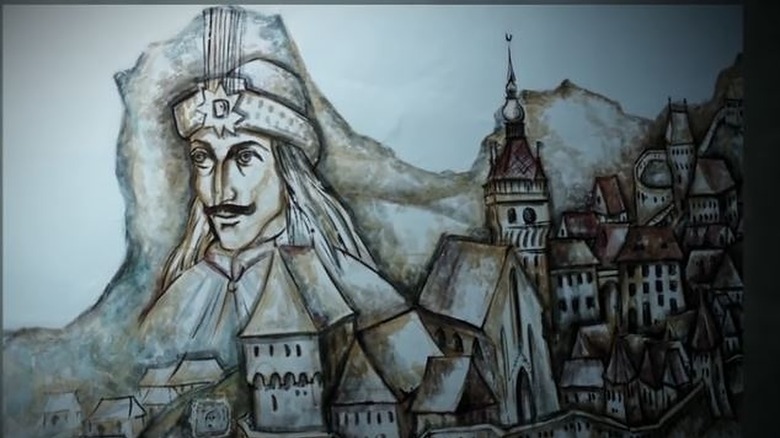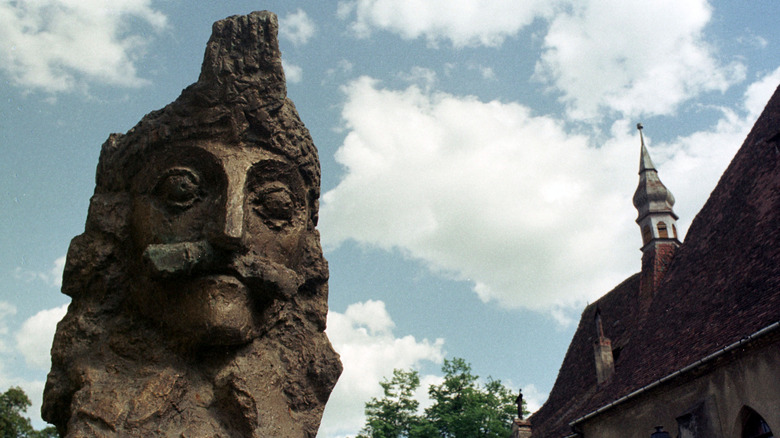How Vlad The Impaler Was Even More Evil Than You Think
Vlad III, better known as Vlad the Impaler, was the ruler of Wallachia (a historical region of Romania) three times between 1448 and his death. While he's considered a national hero of Romania, Vlad has gone down in history as one of the most violent, sadistic rulers in the world (per Britannica).
Vlad was born into the noble Dracul family, earning him the nickname of Dracula, or "son of Dracul." His father ruled the Walachia principality until he was assassinated (along with Vlad's older brother, Mircea II) by Walachian boyars (nobles) in 1447. In 1448, Vlad briefly recovered the command over Wallachia, but it was short lived; after just two months, he was forced to flee. According to Britannica, he wouldn't regain his position as the ruler again for eight years, and he spent much of those eight years torturing and killing as many of his enemies as he could.
There's been much debate about whether Bram Stoker's character Dracula is based on Vlad III. The similarities (including his family name, the use of a stake, and the never-ending "thirst for blood") are too big to ignore, but there's also no proof that Stoker was aware of Vlad's existence at the time.
Impalement was Vlad's favorite killing method
Vlad was not the first to inflict impalement. For centuries, impalement was one of the harshest types of punishments, reserved for traitors and used during times of war. This was a slow, extremely painful and agonizing way to torture somebody. According to All That's Interesting, it could take up to eight days for somebody impaled to die.
Vlad was a more "liberal user" of impalement, killing not only soldiers but also anybody who would associate with his enemies the same way. But Vlad's most infamous use of impalement happened in 1462. Vlad had been in an all-out war with the Ottoman sultan Mehmed II for a while. The sultan wasn't anything to laugh about, either; he conquered Constantinople when he was just 21 years old and then brought the Byzantine Empire to its knees. Ready to get rid of Vlad and his forces, he eventually put together an army of over 90,000 soldiers and marched towards Wallachia's capital city, Târgoviște.
Vlad's army was barely 30,000 and mostly made up of untrained soldiers armed with spears, and eventually, Vlad had no choice but to retreat. On his way out, he left 20,000 impaled Ottoman corpses, which became known as the "forest of the impaled," for the sultan to find within the Târgoviște citadel (via Mental Floss). The sight was so horrifying that the sultan retreated, declaring that he "cannot take the country from a man capable of such extraordinary things" (via the Journal of Dracula Studies).
Vlad also used other just-as-horrible methods to kill the enemy
During his ongoing war with the Ottoman, Vlad used all kinds of methods to destroy the enemy. This would include not only soldiers but also entire villages that were providing supplies to the Ottoman, in hopes of interrupting delivery and make the army weaker. In a letter written by Vlad in 1462, he explains: 'I have killed peasants men and women, old and young, who lived at Oblucitza and Novoselo, where the Danube flows into the sea, up to Rahova..." (as quoted in Bright We Burn).
Because the Ottoman forces were so large and powerful, facing them on the battleground wasn't always the best approach, so Vlad would send his men to poison their wells and torch their crops (via Mental Floss). He would even send sick men to infiltrate them in hopes many of the enemy would get sick and die.
According to History, Vlad would use other barbaric forms of torture as well, including skinning or boiling his enemies alive, decapitation, bone breaking, and disembowelment. He also used impalement as a way to punish the crimes of "baby-killing and adultery," the last of which would require both lovers to be impaled together in the same stake. Impalement was meant to send two different messages: shocking the enemy in hopes of scaring them off, and degrading the victim for the atrocity of their crimes (via the Journal of Dracula Studies).
Vlad actually killed more than just his enemies
While armies and Ottoman sympathizers were on the receiving end of most of Vlad's violence, they weren't the only ones. In addition to the 20,000 people he impaled at Targoviste, Vlad is believed to have killed an additional 60,000 people for a number of crimes that included everything from theft to adultery to treason (per NBC News).
As for those 20,000 he left behind when retreating from the Ottoman — nobody knows where the bodies came from. According to Mental Floss, it's possible Vlad had been stockpiling corpses for a while, collecting bodies from raids and killing prisoners of war. He even added to the display the bodies of Ottoman officials he had killed when they visited to demand tribute — which Vlad, needless to say, refused to pay.
Vlad also took a radical path as a response to political rivals complaining of growing poverty and illness under his rule. According to The Dead Travel Fast, Vlad organized a large banquet for "all the country's sick, lame, poor and blind." He fed them lots of food and wine, then sealed the doors and burned the building down with everybody in it. The poverty problem was, at least temporarily, solved.
The mass murders committed by Vlad the Impaler would be considered genocide if they happened in modern times. When asked about it, former Romanian defense said minister Ioan Mircea Pașcu said that Vlad would certainly stand trial for crimes against humanity today (as quoted in the book "Romania Since 1989: Politics, Economics, and Society").
Some stories might have been exaggerated
Tales of Vlad's plundering raids and cruelty were already circulating during his lifetime. While nobody denies that Vlad the Impaler was one of the most brutal rulers in history, it seems that some historical accounts have had some details added over the centuries. Particularly suspect are some of the stories that include very private and very specific events, such as that the story about the Ottoman envoys who refused to remove their turbans when meeting Vlad. In response, he had the turbans nailed to their skulls (via Live Science).
The stories reported by Saxon historians are particularly colorful and sometimes clearly embellished, including one that describes how Vlad built a copper cauldron with a wooden lid where victims could be trapped and boiled alive. Or the time he forced Tartan prisoners to cannibalize one of their own as punishment for theft (as reported in the book "Dracula: Essays on the Life and Times of Vlad the Impaler"). Other stories describe him as more cruel and depraved than Nero and Caligula, capable of killing children and women, and often torturing peasants without an apparent reason. While he was certainly capable of all kinds of atrocities, chances are at least some of these stories were created by the Germans in an effort to darken Vlad's reputation as a madman as much as possible (via New World Encyclopedia).
